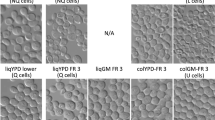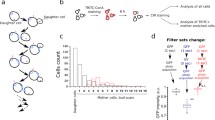Abstract
Cells of the budding yeast Saccharomyces cerevisiae undergo a process akin to differentiation during prolonged culture without medium replenishment. Various methods have been used to separate and determine the potential role and fate of the different cell species. We have stratified chronologically-aged yeast cultures into cells of different sizes, using centrifugal elutriation, and characterized these subpopulations physiologically. We distinguish two extreme cell types, very small (XS) and very large (L) cells. L cells display higher viability based on two separate criteria. They respire much more actively, but produce lower levels of reactive oxygen species (ROS). L cells are capable of dividing, albeit slowly, giving rise to XS cells which do not divide. L cells are more resistant to osmotic stress and they have higher trehalose content, a storage carbohydrate often connected to stress resistance. Depletion of trehalose by deletion of TPS2 does not affect the vital characteristics of L cells, but it improves some of these characteristics in XS cells. Therefore, we propose that the response of L and XS cells to the trehalose produced in the former differs in a way that lowers the vitality of the latter. We compare our XS- and L-fraction cell characteristics with those of cells isolated from stationary cultures by others based on density. This comparison suggests that the cells have some similarities but also differences that may prove useful in addressing whether it is the segregation or the response to trehalose that may play the predominant role in cell division from stationary culture.






Similar content being viewed by others
References
Allen C, Büttner S, Aragon AD, Thomas JA, Meirelles O, Jaetao JE, Benn D, Ruby SW, Veenhuis M, Madeo F, Werner-Washburne M (2006) Isolation of quiescent and nonquiescent cells from yeast stationary-phase cultures. The Journal of Cell Biology. 174:89–100
Aragon AD, Rodriguez AL, Meirelles O, Roy S, Davidson GS, Tapia PH, Allen C, Joe R, Benn D, Werner-Washburne M (2008) Characterization of differentiated quiescent and nonquiescent cells in yeast stationary-phase cultures. Mol Biol Cell 19:1271–1280
Burhans WC, Weinberger M (2012) DNA damage and DNA replication stress in yeast models of aging. In: Breitenbach M, Jazwinski SM, Laun P (eds) Aging research in yeast. Springer, Dordrecht, pp 187–206
Cap M, Vachova L, Palkova Z (2009) Yeast colony survival depends on metabolic adaptation and cell differentiation rather than on stress defense. J Biol Chem 284:32572–32581
Cap M, Stepanek L, Harant K, Vachova L, Palkova Z (2012) Cell differentiation within a yeast colony: metabolic and regulatory parallels with a tumor-affected organism. Mol Cell 46:436–448
Davidson GS, Joe RM, Roy S, Meirelles O, Allen CP, Wilson MR, Tapia PH, Manzanilla EE, Dodson AE, Chakraborty S, Carter M, Young S, Edwards B, Sklar L, Werner-Washburne M (2011) The proteomics of quiescent and nonquiescent cell differentiation in yeast stationary-phase cultures. Mol Biol Cell 22:988–998
Eleutherio E, Panek A, De Mesquita J, Trevisol E, Magalhaes R (2015) Revisiting yeast trehalose metabolism. Curr Genet 61:263–274
Fabrizio P, Longo VD (2003) The chronological life span of Saccharomyces cerevisiae. Aging Cell 2:73–81
Futcher B (2006) Metabolic cycle, cell cycle, and the finishing kick to Start. Genome Biol 7:107
Georgieva M, Moyankova D, Djilianov D, Uzunova K, Miloshev G (2015) Methanol extracts from the resurrection plant Haberlea rhodopensis ameliorate cellular vitality in chronologically ageing Saccharomyces cerevisiae cells. Biogerontology 16:461–472
Henderson KA, Gottschling DE (2008) A mother’s sacrifice: what is she keeping for herself? Curr Opin Cell Biol 20:723–728
Hlavata L, Aguilaniu H, Pichova A, Nystrom T (2003) The oncogenic RAS2 val19 mutation locks respiration, independently of PKA, in a mode prone to generate ROS. The EMBO Journal. 22:3337–3345
Jain NK, Roy I (2010) Trehalose and protein stability. Current protocols in protein science 59:4.9.1–4.9.12
Jazwinski SM (2005) Yeast longevity and aging-the mitochondrial connection. Mech Ageing Dev 126:243–248
Klinger H, Rinnerthaler M, Lam YT, Laun P, Heeren G, Klocker A, Simon-Nobbe B, Dickinson JR, Dawes IW, Breitenbach M (2010) Quantitation of (a)symmetric inheritance of functional and of oxidatively damaged mitochondrial aconitase in the cell division of old yeast mother cells. Exp Gerontol 45:533–542
Kyryakov P, Beach A, Richard VR, Burstein MT, Leonov A, Levy S, Titorenko V (2012). Caloric restriction extends yeast chronological lifespan by altering a pattern of age-related changes in trehalose concentration. Front Physiol 3:256. doi:10.3389/fphys.2012.00256
Lai C-Y, Jaruga E, Borghouts C, Jazwinski SM (2002) A mutation in the ATP2 Gene abrogates the age asymmetry between mother and daughter cells of the yeast Saccharomyces cerevisiae. Genetics 162:73–87
Laun P, Pichova A, Madeo F, Fuchs J, Ellinger A, Kohlwein S, Dawes I, Fröhlich K-U, Breitenbach M (2001) Aged mother cells of Saccharomyces cerevisiae show markers of oxidative stress and apoptosis. Mol Microbiol 39:1166–1173
Lewinska A, Miedziak B, Kulak K, Molon M, Wnuk M (2014) Links between nucleolar activity, rDNA stability, aneuploidy and chronological aging in the yeast Saccharomyces cerevisiae. Biogerontology 15:289–316
Li L, Miles S, Melville Z, Prasad A, Bradley G, Breeden LL (2013) Key events during the transition from rapid growth to quiescence in budding yeast require posttranscriptional regulators. Mol Biol Cell 24:3697–3709
Longo Valter D, Shadel Gerald S, Kaeberlein M, Kennedy B (2012) Replicative and chronological aging in Saccharomyces cerevisiae. Cell Metab 16:18–31
López-Lluch G, Santos-Oscana C, Sánchez-Alcázar JA, Fernández-Ayala DJM, Asencio-Salcedo C (2015) Mitochondrial responsibility in ageing process: innocent, suspect or guilty. Biogerontology 16:599–620
Madeo F, Fröhlich E, Ligr M, Grey M, Sigrist SJ, Wolf DH, Fröhlich K-U (1999) Oxygen stress: a regulator of apoptosis in yeast. J Cell Biol 145:757–767
Mirisola MG, Braun RJ, Petranovic D (2014) Approaches to study yeast cell aging and death. FEMS Yeast Res 14:109–118
Murakami C, Delaney JR, Chou A, Carr D, Schleit J, Sutphin GL, An EH, Castanza AS, Fletcher M, Goswami S, Higgins S, Holmberg M, Hui J, Jelic M, Jeong K-S, Kim JR, Klum S, Liao E, Lin MS, Lo W, Miller H, Moller R, Peng ZJ, Pollard T, Pradeep P, Pruett D, Rai D, Ros V, Schuster A, Singh M, Spector BL, Vander Wende H, Wang AM, Wasko BM, Olsen B, Kaeberlein M (2012) pH neutralization protects against reduction in replicative lifespan following chronological aging in yeast. Cell Cycle 11:3087–3096
Navarre C, Goffeau A (2000) Membrane hyperpolarization and salt sensitivity induced by deletion of PMP3, a highly conserved small protein of yeast plasma membrane. EMBO J 19:2515–2524
Noubhani A, Bunoust O, Bonini BM, Thevelein JM, Devin A, Rigoulet M (2009) The trehalose pathway regulates mitochondrial respiratory chain content through Hexokinase 2 and cAMP in Saccharomyces cerevisiae. J Biol Chem 284:27229–27234
Nystrom T, Liu B (2014) The mystery of aging and rejuvenation—a budding topic. Curr Opin Microbiol 18:61–67
Palková Z, Wilkinson D, Váchová L (2014) Aging and differentiation in yeast populations: elders with different properties and functions. FEMS Yeast Res 14:96–108
Parrou JL, François J (1997) A simplified procedure for a rapid and reliable assay of both glycogen and trehalose in whole yeast cells. Anal Biochem 248:186–188
Schuller C, Brewster JL, Alexander MR, Gustin MC, Ruis H (1994) The HOG pathway controls osmotic regulation of transcription via the stress response element (STRE) of the Saccharomyces cerevisiae CTT1 gene. The EMBO Journal. 13:4382–4389
Shi L, Sutter BM, Ye X, Tu BP (2010) Trehalose is a key determinant of the quiescent metabolic state that fuels cell cycle progression upon return to growth. Mol Biol Cell 21:1982–1990
Volejníková A, Hlousková J, Sigler K, Pichová A (2013) Vital mitochondrial functions show profound changes during yeast culture ageing. FEMS Yeast Res 13:7–15
Wei Y, Zhang YJ, Cai Y (2013) Growth or longevity: the TOR’s decision on lifespan regulation. Biogerontology 14:353–363
Woldringh CL, Fluiter K, Huls PG (1995) Production of senescent cells of Saccharomyces cerevisiae by centrifugal elutriation. Yeast 11:361–369
Zadrag-Tecza R, Kwolek-Mirek M, Bartosz G, Bilinski T (2009) Cell volume as a factor limiting the replicative lifespan of the yeast Saccharomyces cerevisiae. Biogerontology 10:481–488
Acknowledgments
The work was supported by the Grant LH13049 of the CR Ministry of Education, Youth and Sports, internal institutional project RVO 61388971 of Institute of Microbiology Acadamy of Sciences of the Czech Republic and by Grant AG006168 from the National Institute on Aging of the National Institutes of Health (U.S.P.H.S.) to SMJ. We acknowledge the Cytometry and Microscopy Facility at the Institute of Microbiology Acadamy of Sciences of the Czech Republic, v.v.i, Videňska 1083, Prague, CZ for the use of cytometry equipment and the support from the staff.
Author information
Authors and Affiliations
Corresponding author
Electronic supplementary material
Below is the link to the electronic supplementary material.
Rights and permissions
About this article
Cite this article
Svenkrtova, A., Belicova, L., Volejnikova, A. et al. Stratification of yeast cells during chronological aging by size points to the role of trehalose in cell vitality. Biogerontology 17, 395–408 (2016). https://doi.org/10.1007/s10522-015-9625-5
Received:
Accepted:
Published:
Issue Date:
DOI: https://doi.org/10.1007/s10522-015-9625-5




